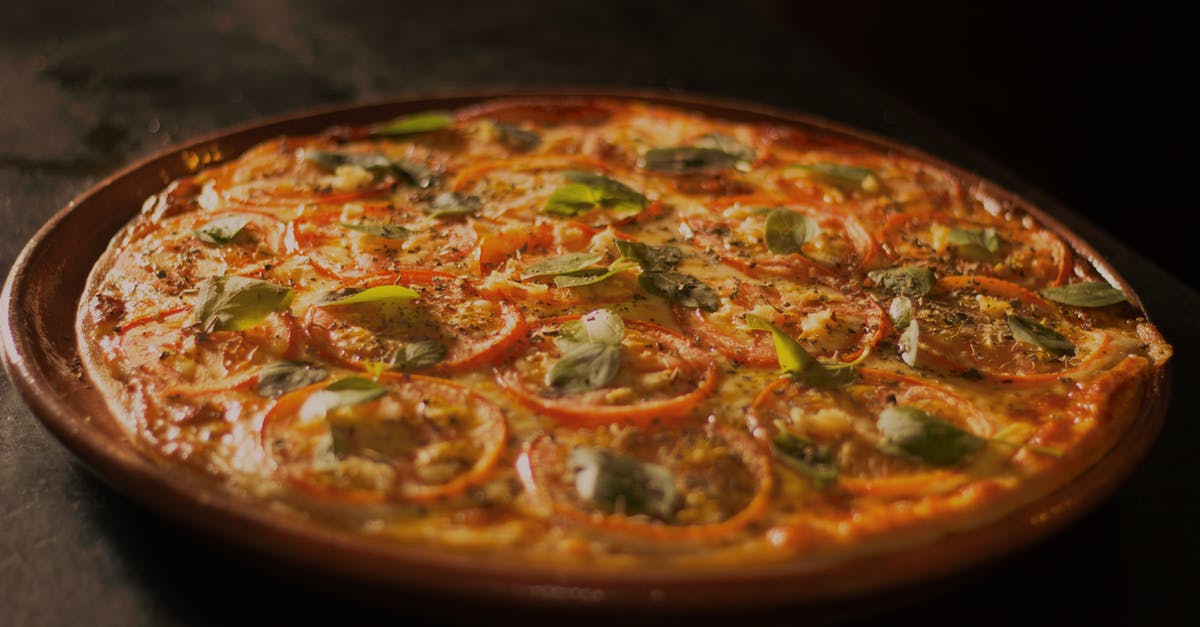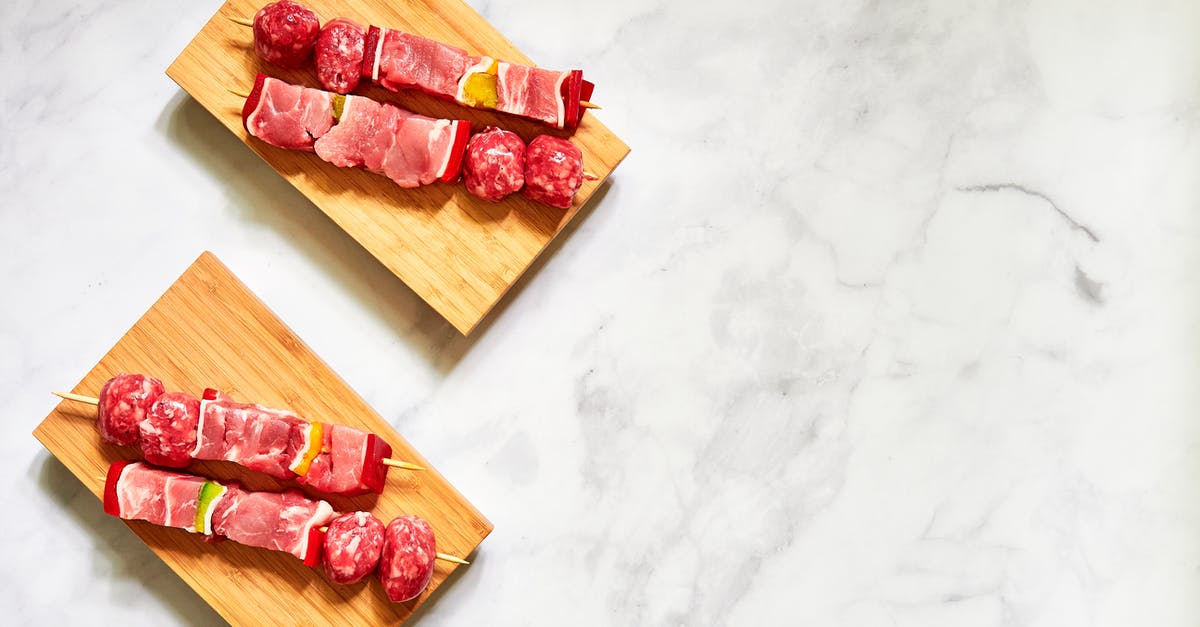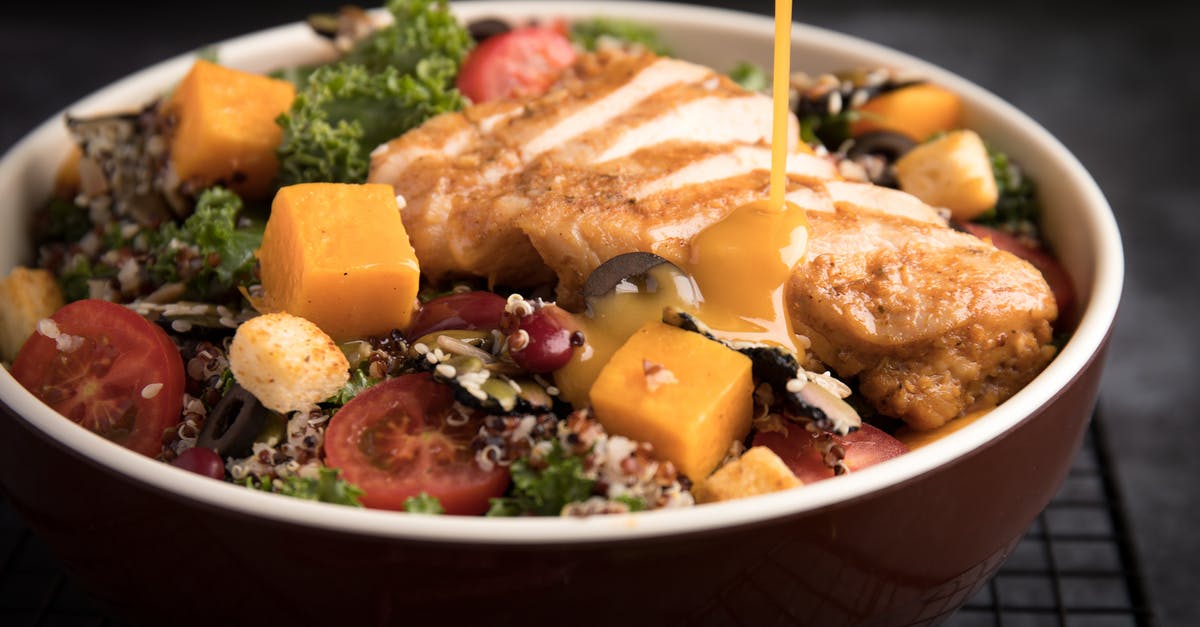Why is meat red?

What makes meat red? At first I would think it is the blood, but most packaged meat doesn't seem to be bloody per se, and plus, different meats (chicken, beef etc.) range in color from deep red to light pink. Additionally, why would cooking the meat turn it black/gray/white if the color is from the blood?
Could it possibly be just the color of the muscle proteins?
Best Answer
As the USDA says, the protein myoglobin is the main cause of the red color of meat; it achieves this color when exposed to oxygen. Red meat (or dark meat) is myoglobin-rich, from "slow-twitch" endurance muscles, while white meat has little myoglobin, and is from "fast-twitch" muscles. So it really is the protein in the meat, as you guessed! But we can understand better than that.
Myoglobin is related to hemoglobin, which is in blood: myoglobin has a heme group while hemoglobin has four heme groups. In both cases the heme groups are bound up in a globular protein (a globin); that surrounding structure is very different in the two proteins. Heme groups are good-sized organic molecules, but the important thing is that at their center, there's an ionized iron atom, which is capable of binding to various other things, allowing things like hemoglobin transporting oxygen in blood, and myoglobin temporarily holding onto oxygen the muscle cells will use soon. Myglobin is most present in slow-twitch muscles, which are used frequently or continuously, and so need the stores of oxygen for endurance - these muscles are what we call red (or dark) meat. Fast-twitch muscles, used for quick burst of energy, don't need these oxygen stores, so they don't have much myoglobin.
The central part of heme looks something like this:

The gray bonds around the edges are the connections to the rest of the molecule, which we don't care about right now. It's the various things that can bind to the iron atom (that question mark) that are responsible for the color of both blood and red meat. There are several states we see in meat:
- When there's no oxygen bound to it, it's bound to water, and is purple/blue. We know this as the color of blood in veins, but you can sometimes see this in vacuum-packed meat, which isn't exposed to oxygen at all. The iron is in the +2 oxidation state (two electrons removed).
- With oxygen bound to it, which happens instantly when exposed to air, it's red. This is true for blood which has collected oxygen from the lungs, as well as meat in the state we usually see it. Again, the iron is in the +2 oxidation state.
- With the iron ionized further into the +3 state, it can again bind to water, turning brown. This happens after prolonged periods without exposure to much oxygen, for example, meat that's been stored in its packaging for a while. It also happens when the protein is destabilized by acidity or temperature, explaining why cooked meat turns brown. If you cook it slowly at a low temperature, the protein isn't destabilized as much, and some pink color can remain.
- With nitric oxide bound to it, which happens in both cured meats and smoked meats, it turns pink. Similarly, carbon monoxide in oxygen-deficient gas or charcoal grills can also turn it pink.

There's a great deal of variety in myoglobin content of various meats, accounting for much of the variation in color. It all depends on the animal and the role of the muscle. Remember, the myoglobin is used for temporary oxygen storage. This means that more powerful, frequently-used muscles need a lot of myoglobin - for example, young cattle aren't using their muscles much yet and have less myoglobin, while whale muscles, which are constantly used and need to last through prolonged dives, have 25 times as much myoglobin and look black. This is actually pretty cool from a nutritional standpoint: the redder the meat is, the more iron it has!
Whew! So that's red meat. White meat, on the other hand, is from myoglobin-poor fast-twitch muscles, so it doesn't get in on all that exciting color-changing stuff. Poultry breasts as well as a lot of fish fall into this category. While some fish (like tuna) have plenty of slow-twitch endurance muscle, most fish don't need a whole lot, because cruising in water is relatively easy. They instead have a lot of fast-twitch muscle for quick turns and sprints, with a layer of slow-twitch muscle near the skin - this is the dark layer you see in some fish!
In addition to the Wikipedia articles above, this answer includes significant information from the always excellent On Food and Cooking, by Harold McGee - notably it contains nice little diagrams of the various heme states. Much of the same information can be found scattered around the internet. Wikipedia's Temperature (meat) article briefly covers the cooking transformations. For the variety of meat colors, there's this Exploratorium "Science of Cooking" article or this Library of Congress answer about white/dark meat in turkey.
Pictures about "Why is meat red?"



Quick Answer about "Why is meat red?"
The protein myoglobin stores oxygen in muscle cells, which use oxygen to extract the energy needed for constant activity. Myoglobin is a richly pigmented protein. The more myoglobin there is in the cells, the redder, or darker, the meat.Is red meat red because of blood?
When purchasing red meat, including steaks, many grocery shoppers often find red liquid in the bottom of the packaging, which you probably assumed was blood. It turns out, it's not actually blood, but rather a protein called myoglobin, according to Buzzfeed.What makes meat red or white?
White and red meat differ in their amount of myoglobin, the protein responsible for a meat's color. Red meat has more myoglobin than white meat, and a higher myoglobin content generates a darker meat color.Why is Red Meat ... Red?
More answers regarding why is meat red?
Answer 2
As The Color of Meat and Poultry article from the USDA Food Safety and Inspection Service explains:
Myoglobin, a protein, is responsible for the majority of the red color. When it is mixed with oxygen, it becomes oxymyoglobin and produces a bright red color. The remaining color comes from the hemoglobin which occurs mainly in the circulating blood, but a small amount can be found in the tissues after slaughter.
Color is also influenced by the age of the animal, the species, sex, diet, and even the exercise it gets. The meat from older animals will be darker in color because the myoglobin level increases with age. Exercised muscles are always darker in color, which means the same animal can have variations of color in its muscles.
In addition, the color of meat and poultry can change as it is being stored at retail and in the home. When safely stored in the refrigerator or freezer, color changes are normal for fresh meat and poultry.
Change in color alone does not mean the product is spoiled. Color changes are normal for fresh product. With spoilage there can be a change in color—often a fading or darkening. In addition to the color change, the meat or poultry will have an off odor, be sticky or tacky to the touch, or it may be slimy. If meat has developed these characteristics, it should not be used.
Sources: Stack Exchange - This article follows the attribution requirements of Stack Exchange and is licensed under CC BY-SA 3.0.
Images: Edward Eyer, Pixelme Stock Photography, kei photo, Max Vakhtbovych
